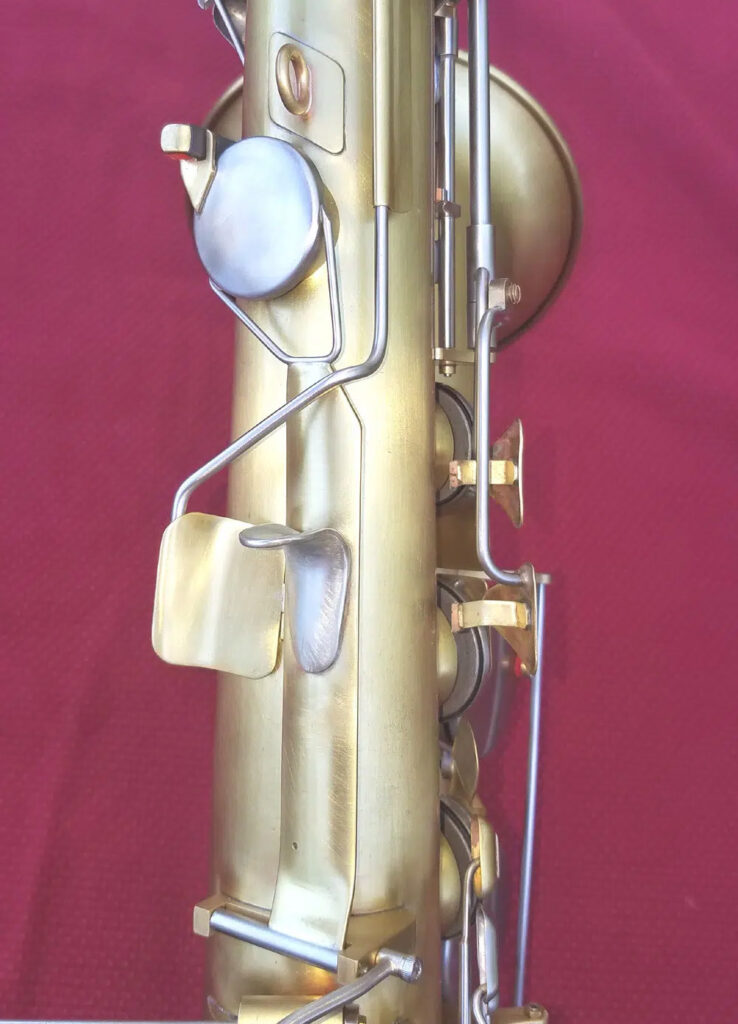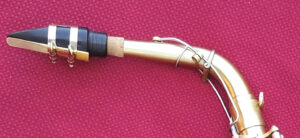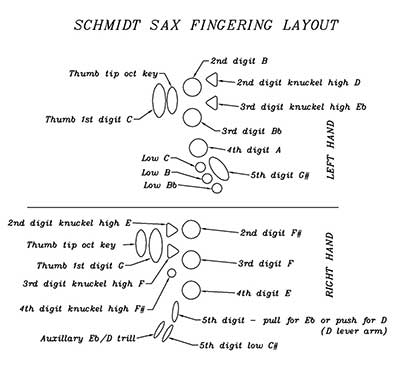

THE NEW SAX DESIGN
by JIM SCHMIDT
If you dig common sense, practicality, good technology and comfortable ergonomics, read on.
The logic behind my fingering system is straightforward. One note follows the next chromatic note by closing down the next key with the next finger of your hand, and so on down the line, one after the other in linear sequence.
This new fingering system is easy to memorize. Chromatic scales sound wonderfully smooth. All scales, regardless of how many sharps or flats are involved, can be easily played. As you know, the conventional fingering is built around the C major scale with the sharps and flats of other scales inserted where they can fit. Because of this, scales with more sharps and flats become difficult to play. The JS sax design overcomes this problem because it is based on the chromatic scale – the only scale to include all twelve notes of the octave.
The Schmidt chromatic fingering makes perfect sense and is a pleasure to play. Since the tone holes are generally located directly underneath the fingers being applied, the player understands that he/she is making the sax longer and dropping the pitch by applying more fingers, making it shorter and raising the pitch by lifting fingers, or venting it for altissimo by lifting some fingers and closing others. This direct link of fingers over tone holes enables players to visualize what they are doing to the sax. It encourages them to use more creativity and intelligence in their playing. For example: it is easy to transpose down a third by simply pressing down 4 more fingers on their keys.
When you look at a conventional sax you see a lot of complicated interconnecting linkages, unnecessary weight and redundant keys (side keys, bis key, F#, Bb. G# etc.). In the new system, scales and tones are cleaner and quicker because each key is independent (except the low note keys) and is not loaded down by interlinkage mechanisms as are, for instance, mid Bb and F# in the conventional Boehm method. Tones are also clearer because you have the choice of closing only those holes which produce the best sound. This is especially true when playing altissimo (the conventional sax locks you out of some of the best altissimo fingerings). This fingering system allows you to do much more. For example, low note trills and interval tremolos are now available – a big advantantage over conventional horns. A unique technique is employed to achieve this which allows two fingers to operate the low note touchpieces instead of just the pinky. For example – you can hold down low B with the ring finger while trilling low Bb with the pinky. This is easy because spring pressures are about 1/2 as heavy as found on conventional horns.

THUMB KEYS
Both thumbs are used to operate the keys. The right thumb key is an unusual combination of touch piece and thumb hook. A special guard keeps the sax clear of the players body so that the right thumb is free to operate its key. This guard reduces pressure on the right thumb and improves the stability, comfort and balance of the horn. There is also a special right thumb tip key which operates only the neck octave vent – this key facilitates the secure playing of harmonics, upper partials, multiphonics, etc.
SLEEK COMFORT
Sleek, high strength keys which are formed from stainless steel which does not wear and become sloppy like brass keys. They are designed to be much stronger and resist bending which would upset the precise seal of the pads. Conventional key cups and pads are clumsy and heavy by comparison. Lightweight stainless steel keywork offers more control, a better feel, and the lighter, faster action.
PALM KEYS
The top keys have been designed to be played with either the undersides of ones knuckles (as with conventional palm keys) or with the fingertips. Using the fingertips improves playability and overcomes the clumsy limitations of palm keys.

CLEAN CONSTRUCTION
Messy looking posts and ribs have been replaced by one piece bridges in order to clean up construction and eliminate solder joints. This enables the sax to project with greater clarity, tone color, and volume. It’s closer to the ideal of a bare resonate horn unencumbered by key work.
More even spring pressures throughout the key system due to the elimination of interlinkage mechanisms (such as Bb and F# on conventional saxes). The keys require minimum closing pressure to seal the pads. This feature allows the player to play faster and longer without tiring. Players find my touchpiece layout to be more ergonomic and considerate to the hands than conventional horns..
Excellent intonation due to the fact that there are no flattened or shaded notes (which occurs with Boehm interlinkages). This allows for an even graduation of tone hole size and location, allowing correct location at the exact nodes of the scale which in turn provides better response, tone production and intonation.
JS Gold pads are quiet, form an excellent seal and are much longer lasting and superior to conventional pads. Skin deterioration, moisture warpage and all those other headaches are no longer a problem. Gold pads reflect more tone than conventional leather pads which act like mufflers by dampening out the sonic qualities of your horn. Leather pads will fit right into my stainless steel cups if you should choose to install them.
The conical taper and bore dimensions of the entire horn is borrowed from the venerable Selmer MKVI (Alto and Tenor) along with slight adjustments to improve the intonation.

Young musicians are naturally attracted to this new design. The chromatic layout makes it easy for a beginner to find correct notes.
Advanced players find tremendous potential at their fingertips. Tone quality is improved for classical playing, accelerated passages are available for the jazz artist, and a whole new horizon opens up for extended techniques.
QUOTES
From professional players and recording artists who either own my instruments or have played them. I have not asked them to endorse my product, so I am not including their names.
“It has acoustical advantages over the Boehm system. The tone is better [than conventional horns] over a wider range of pitch bending [lipping].”
“This fingering system is not key weighted” [it does not favor one key signature over another].
“It has an amazing live sound” “…super rich in harmonics that I dig enormously.”
“Amazing, wonderful, it could be dangerous. Better have it registered with the authorities”
“The musical extension of the number of possible multiphonics is fantastic.”
“Extraodinary qualities …It speaks immediately and has a full and consistent tone, top to bottom.”







